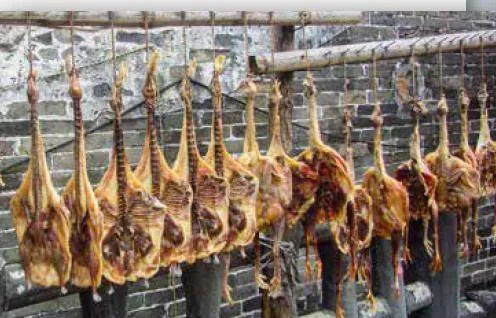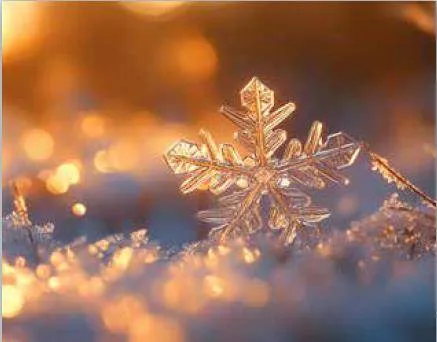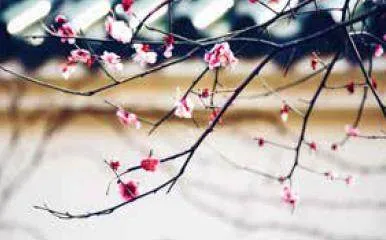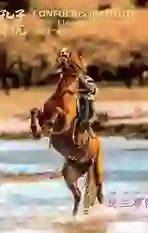二十四节气之大雪和冬至
2024-01-01郭心怡








大雪是二十四节气中的第21个节气,通常在每年公历的12月6日—8日之间。此时,中国北方大部分地区的最低气温会降到0℃以下,甚至可能会下大雪,所以这个节气被称作“大雪”
Daxue, or Major Snow, is the 21st of the 24solar terms, usually falling between December6th and 8th on the Gregorian calendar. Duringthis time, the lowest temperatures in mostparts of northern China drop below 0 °C, andheavy snowfall is possible, which is why thisperiod is called “Major Snow.”
大雪时节,天气寒冷。人们会减少户外活动,选择“窝”在家里休养生息,于是有了“窝冬”的说法。此时也是进补的好时节,民间有一种说法,叫作“冬天进补,开春打虎”,意思是这个时候补充一些营养丰富的食物,能促进体内阳气的生发,帮助人们抵御寒冷。
The Daxue season is marked by cold weather.People tend to reduce outdoor activities and stay athome to rest, giving rise to the phrase “nesting forwinter.” It is also an ideal time for nourishment,with a traditional saying: “Supplement in winter,fight a tiger in spring.” It means that eatingnutrient-rich foods during this period will helpboost the body’s yang energy, aiding in resistanceto the cold.
中国有些地区有“大雪腌肉”的习俗,人们在这个时节用盐巴和大料等腌制牛羊鸡鱼等各种肉类,为即将到来的新年盛宴增添美味。
In some regions of China, there is a custom ofcuring meat during the Daxue period. People usesalt, spices, and other seasonings to preserve beef,lamb, chicken, and fish, adding delicious flavors tothe upcoming New Year’s feast.
春种,夏长,秋收,冬藏,天地万物皆遵循四季轮回的自然法则。冬季虽是农民们的农闲时间,但大雪时节的降雪可为农事提供水量的储备,所谓“瑞雪兆丰年”便是这个意思。人们祈愿冬日里的降雪能滋润土地,带来一年的丰收。
The cycle of nature follows the seasons: springplanting, summer growth, autumn harvest, andwinter storage. While winter is a time of rest forfarmers, snowfall during the Daxue period helpsstore water for the fields. This is the meaningbehind the saying, “A timely snow promises agood harvest.” People hope that winter snowfallwill nourish the land and lead to a bountiful yearahead.
其实,大雪时节不一定就会下雪,更不一定就会下大雪。二十四节气的命名主要以中国黄河流域的气候为依据。在中国的南方,冬天没那么冷,有的地方几乎从不下雪,更别提大雪了。南方人只能羡慕“大雪地区”的人们能享有冬日特别福利——赏雪景、滑雪、滑冰、堆雪人、打雪仗……大雪时节独特的“礼物”为北方萧索的冬日带来了乐趣。
That said, Daxue doesn’t alwaysbring snow, and it certainly doesn’talways bring heavy snow. The 24 solarterms are primarily based on theclimate of China’s Yellow River Basin.In southern China, winters are muchmilder, and some areas hardly eversee snow, let alone heavy snow. Peoplethere can only envy those in snowyregions who get to enjoy winter’s specialtreats — admiring snowy landscapes,skiing, skating, building snowmen, andhaving snowball fights. These unique“gifts” of the Daxue period bring joyto the otherwise bleak northern winterdays.
冬至是二十四节气中的第22个节气,通常在每年公历的12月21日—23日之间。这一天,太阳光直射南回归线,是北半球各地白昼最短、黑夜最长的一天。然后,太阳直射点就开始向北返回,北半球的白昼将会一天天增长。
Dongzhi, or the Winter Solstice, isthe 22nd of the 24 solar terms, typicallyoccurring between December 21st and 23rdon the Gregorian calendar. On this day,the sun shines directly over the Tropic ofCapricorn, making it the shortest day andlongest night of the year in the NorthernHemisphere. After the day of Dongzhi, thesun begins its journey back north, and thedays in the Northern Hemisphere graduallybecome longer.
中国的古人很早就发现了这个规律。他们将冬至看作阴阳转折的节点,认为从这天起,天地间的阴气开始衰退,阳气日渐兴盛,所以,冬至是个大吉的日子。因此,冬至自古就是中国最重要的节气之一,民间一直有“冬至大如年”的说法。人们会在这天换上新衣服,准备丰盛的食物,祭祀祖先和神灵,希望来年一切顺利;古代帝王还会到天坛举行祭天大典。
Ancient Chinese people discoveredthis pattern early on and viewed the WinterSolstice as a turning point between yinand yang. They believed that from this dayonward, the yin energy in the world beginsto wane, and the yang energy starts to growstronger. For this reason, the Winter Solsticewas considered a highly auspicious day. Ithas long been one of the most importantsolar terms in China, with a commonsaying, “The Winter Solstice is as significantas the New Year.” People would put onnew clothes, prepare elaborate meals, andmake sacrifices to ancestors and deities inthe hope of a smooth and prosperous year ahead. In ancient times, emperors would also holdgrand worship ceremonies at the Temple of Heavenon this day.
中国各地过冬至节的习俗不尽相同。在北方,人们必定要在冬至吃饺子,所谓“冬至不端饺子碗,冻掉耳朵没人管”。饺子的形状和耳朵的形状相似,因此在冬至吃饺子就有“消寒”的意思。而在南方,人们通常会在冬至吃汤圆,“圆”意味着圆满、团圆,一颗颗软糯的汤圆下肚,代表了“团团圆圆”的美好祝愿。冬至时节的饮食习俗,承载着中国独特的饮食文化。但无论天南地北,这些食品中都隐含着人们对生活、对家人的美好愿景。
The customs for celebrating the DongzhiFestival vary from region to region in China. In thenorth, it’s a tradition to eat dumplings on this day.There’s a saying: “If you don’t eat dumplings on theWinter Solstice, your ears will freeze off and no onewill care.” Since dumplings are shaped somewhatlike ears, eating them on the day of Dongzhisymbolizes warding off the cold. In the south,people usually eat tangyuan (glutinous rice balls),as the round shape represents unity and reunion.With each bite of these soft, sweet rice balls, peopleexpress their wishes for togetherness and harmony.These culinary traditions reflect China’s uniqueDongzhi Festival food culture, and whether in thenorth or the south, these foods embody the love andwarmth that people have for life and their families.
冬至时节万树寒无色,唯有冰姿仙风的梅花凌霜傲雪。人们赏梅、咏梅、画梅,渐渐衍生出冬日里最诗意的“日历”——梅花形制的“九九消寒图”。冬至那天,人们先绘制一支梅花,枝上有花九朵,每朵上面有九片花瓣。每过一天,便根据不同的天气为一片花瓣画上不同颜色,晴染红、雨沁绿、阴点蓝、风画黄、雪落白,随着不同天气给花瓣画上不同的颜色。在最寒冷的季节中,人们望着点缀寒枝的缤纷梅花,仿佛已逐渐嗅到春日的气息。冬至时节过后,白昼的时间也逐渐变长,寒冬即将过去,人们看到了春天的希望。地下的阳气也渐渐复苏,人们开始期待春天的到来。
During the Dongzhi period, when thetrees are bare, only the plum blossomsstand proudly against the frost andsnow, exuding an ethereal beauty. Peopleadmire them, write poems, and createpaintings, giving rise to the most poeticwinter tradition — the “Nine by NineDiagram” calendar. This diagram featuresa plum branch with nine blossoms,drawn on the very day of Dongzhi,each blossom bearing nine petals. Eachday, one petal is colored based on theweather: red for sunny days, green forrain, blue for cloudy skies, yellow forwind, and white for snow. As the colorfulpetals begin to adorn the cold branches,it feels as if the scent of spring is alreadyin the air. After the Dongzhi period, thedays grow longer and the harsh winterbegins to fade, offering a glimpse ofthe coming spring. As the yang energybeneath the earth awakens, people lookforward to the arrival of spring withrenewed hope.
